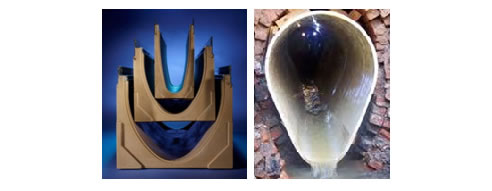Trench Drains and Hydraulic Performance by ACO Left: V-shaped trench drains, and Right: ACO's v-shaped polycrete channels. The Shape of a Trench Drain and How it Affects Hydraulic Performance The inner shape of a trench drain has a significant influence on its hydraulic performance. The material from which this inner section is created also makes a difference; with smooth surfaces preferred over bumpy or rough concrete. If trench drains are incorrectly designed, they will lack the ability to clear rainwater efficiently. When this happens, pavements are likely to cost developers in maintenance and repair. In our previous article, we described how the slope had a considerable impact on the performance of a trench drain's hydraulics. In particular, we discussed how it helps determine the velocity of the liquid that flows through it. Water travels downhill, and if the pavement cannot assist in this endeavour, then the drainage must be configured to provide the necessary falls, preferably by implementing a slope in the base of a trench run. Factory manufactured sloped channels enable sufficient drainage, while a stepped configuration isn't as likely to have as great of an affect on a drain's hydraulic performance. In this article, we're going to look at how the shape of a trench drain impacts hydraulic performance. Hydraulic Properties of V Shaped Trench Drains When considering hydraulic properties of trench drains, the ultimate piece of the puzzle is the internal shape of the drainage channel. Inspired by the shape of traditional egg (V) shaped sewers; ACO has transferred these benefits to its external drainage systems.
|
1300 765 226 Emu Plains, NSW, 2750
|




 Sloped Trench Drains for Sports
Sloped Trench Drains for Sports Heelsafe Anti-slip Grates and Covers
Heelsafe Anti-slip Grates and Covers Balcony Drains for Sydney Apartments
Balcony Drains for Sydney Apartments Bridge Stormwater Drainage with
Bridge Stormwater Drainage with Custom Sloped Channel Drainage for Pools
Custom Sloped Channel Drainage for Pools Slip-Resistant Push-Fit Drainage for
Slip-Resistant Push-Fit Drainage for Grease Management and Drainage for
Grease Management and Drainage for Freestyle Architectural Drain Grates -
Freestyle Architectural Drain Grates - Surface Water & Cable Management of Rail
Surface Water & Cable Management of Rail KerbDrain Trench Drain System for Camden
KerbDrain Trench Drain System for Camden Trench Drain Shape and Hydraulic
Trench Drain Shape and Hydraulic Multipart Access Cover Installation
Multipart Access Cover Installation Drainage for Road Infrastructure by ACO
Drainage for Road Infrastructure by ACO Steel Production for Construction Across
Steel Production for Construction Across Surface Drainage for Construction by ACO
Surface Drainage for Construction by ACO Non-Slip Drainage for Public Area from
Non-Slip Drainage for Public Area from Hygienic Grease Management for
Hygienic Grease Management for Grease Management and Drainage System
Grease Management and Drainage System Trench Drains for Transport
Trench Drains for Transport New Trench Drain Technical Handbook by
New Trench Drain Technical Handbook by
